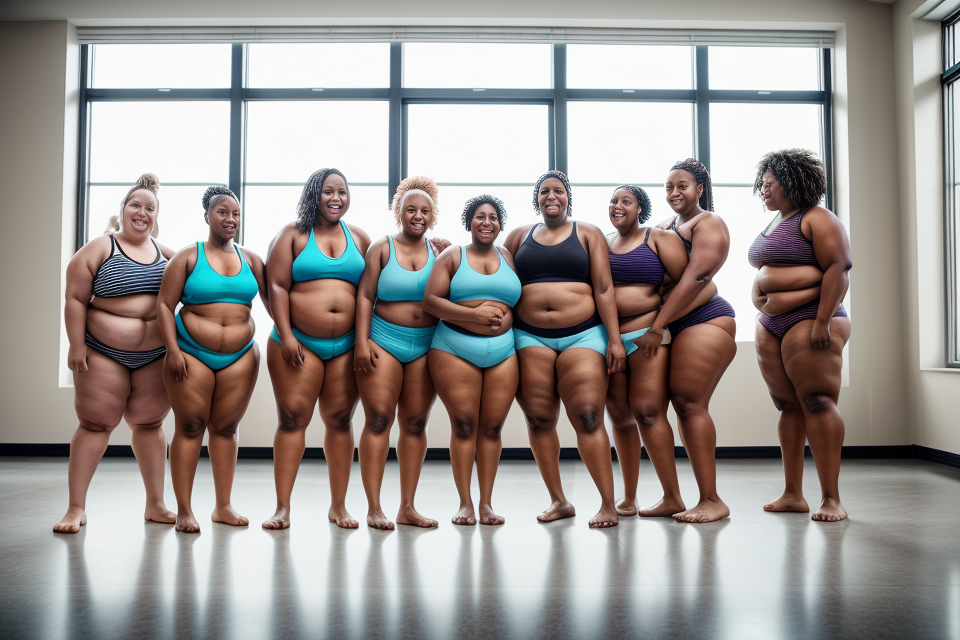
Body positivity has been a growing movement in recent years, encouraging individuals to love and accept their bodies for what they are. However, there is still a common misconception that body positivity and weight loss are mutually exclusive. In this comprehensive guide, we will explore how one can maintain a positive body image while still working towards weight loss goals. It’s important to understand that weight loss doesn’t have to be about self-hatred or changing one’s body, but rather about making healthy choices for one’s well-being. Let’s dive in and discover how to embrace body positivity while striving for a healthier lifestyle.
Embracing Body Positivity: What, Why, and How?
Understanding Body Positivity
The origins and evolution of body positivity
Body positivity has its roots in the feminist movement of the 1960s and 1970s, which aimed to challenge traditional beauty standards and promote self-acceptance and self-love. However, it was not until the 21st century that the concept gained widespread attention, particularly with the rise of social media platforms and the increasing availability of diverse representations of bodies in the media.
The evolution of body positivity has been marked by a shift from simply rejecting traditional beauty standards to embracing and celebrating all bodies, regardless of size, shape, or appearance. This inclusive approach seeks to promote self-love, self-acceptance, and body empowerment for individuals of all backgrounds and experiences.
Key principles and values of body positivity
Body positivity is grounded in several key principles and values, including:
- Self-love and self-acceptance: Embracing and loving oneself, including one’s body, is the foundation of body positivity. It involves acknowledging and accepting one’s body as it is, without the need for external validation or comparison to others.
- Diversity and inclusivity: Body positivity recognizes that all bodies are unique and valuable, and that everyone deserves to feel comfortable and confident in their own skin, regardless of size, shape, or appearance.
- Empowerment and self-care: Body positivity promotes self-care and self-empowerment, encouraging individuals to prioritize their physical and emotional well-being and to make choices that support their overall health and happiness.
- Challenging societal beauty standards: Body positivity seeks to challenge and subvert traditional beauty standards that promote thinness, perfection, and conformity, and instead promote a more inclusive and diverse representation of beauty.
Overall, body positivity is a philosophy that values and celebrates the diversity of human bodies, promoting self-love, self-acceptance, and empowerment. It encourages individuals to embrace their bodies as they are, and to prioritize their physical and emotional well-being.
Benefits of Body Positivity
Improved self-esteem and self-worth
Body positivity has been shown to improve self-esteem and self-worth. By accepting and appreciating one’s body, individuals are more likely to develop a positive self-image and feel better about themselves overall. This, in turn, can lead to increased confidence and a greater sense of self-worth.
Enhanced mental health and well-being
Embracing body positivity has also been linked to enhanced mental health and well-being. By focusing on self-acceptance and self-love, individuals can reduce negative self-talk and eliminate feelings of guilt or shame associated with their bodies. This can lead to improved mood, reduced anxiety and depression symptoms, and an overall sense of well-being.
Better relationships with one’s body and self
Body positivity can also help individuals develop better relationships with their bodies and themselves. By learning to appreciate their bodies for what they can do, rather than how they look, individuals can cultivate a more positive and healthy relationship with their bodies. This can lead to greater self-care, improved physical health, and a more positive outlook on life overall.
Putting Body Positivity into Practice
Cultivating a positive body image
One way to put body positivity into practice is by cultivating a positive body image. This involves learning to appreciate and accept one’s body for its unique qualities and abilities, rather than focusing on perceived flaws or imperfections. Some strategies for cultivating a positive body image include:
- Practicing self-compassion: Treating oneself with kindness, understanding, and acceptance, rather than harsh self-criticism or judgment.
- Reframing negative thoughts: Identifying and challenging negative thoughts or beliefs about one’s body, and replacing them with more positive and realistic ones.
- Focusing on strengths and abilities: Highlighting and celebrating one’s physical strengths and abilities, rather than focusing solely on appearance.
Challenging societal beauty standards
Another key aspect of putting body positivity into practice is challenging societal beauty standards that promote unrealistic and harmful body ideals. This can involve:
- Educating oneself about the origins and effects of these standards, and how they perpetuate body dissatisfaction and low self-esteem.
- Supporting and amplifying the voices of marginalized communities who are often excluded or erased from these standards.
- Encouraging others to challenge these standards by sharing information and resources, and advocating for more inclusive and diverse representations of beauty.
Accepting and celebrating one’s body
Accepting and celebrating one’s body is also an important part of putting body positivity into practice. This involves embracing one’s body as it is, rather than striving for an unattainable ideal. Some ways to do this include:
- Practicing self-care: Taking care of one’s physical and emotional well-being through activities such as exercise, healthy eating, and relaxation.
- Seeking out positive and affirming messages: Surrounding oneself with positive and affirming messages about body image, whether through social media, literature, or other sources.
- Celebrating progress and successes: Acknowledging and celebrating progress and successes, no matter how small, in accepting and loving one’s body.
Weight Loss: Motivations, Goals, and Strategies
Understanding Weight Loss Motivations
When it comes to weight loss, motivation plays a crucial role in determining the success of an individual’s journey. There are two main types of motivations that drive individuals to lose weight: intrinsic and extrinsic.
Intrinsic motivations for weight loss
Intrinsic motivations refer to the internal factors that drive an individual to lose weight. These factors may include a desire to improve one’s health, increase energy levels, or feel more confident in their own skin. People who are intrinsically motivated to lose weight tend to be more successful in reaching their goals, as they are driven by a genuine desire to make positive changes in their lives.
Extrinsic motivations for weight loss
Extrinsic motivations, on the other hand, refer to external factors that may influence an individual’s decision to lose weight. These factors may include social pressure, media influence, or a desire to conform to societal beauty standards. While extrinsic motivations may provide initial motivation, they may not be as sustainable in the long run, as they are often driven by external factors rather than personal desires.
It is important to understand one’s own motivations for weight loss, as this can help in developing a more effective and sustainable weight loss plan. For instance, individuals who are intrinsically motivated to lose weight may find it easier to maintain a healthy lifestyle, as they are driven by a genuine desire to improve their health and wellbeing. On the other hand, those who are extrinsically motivated may find it more challenging to maintain their weight loss goals, as they may be more focused on short-term results rather than long-term sustainability.
Understanding one’s motivations for weight loss is also crucial in developing a healthy relationship with food and one’s body. When individuals are driven by intrinsic motivations, they are more likely to adopt a healthy and sustainable approach to nutrition and exercise, rather than adopting restrictive or fad diets that may lead to disordered eating patterns and negative body image.
In conclusion, understanding one’s motivations for weight loss is a crucial step in developing a successful and sustainable weight loss plan. Whether intrinsic or extrinsic, it is important to identify one’s own motivations and use them as a driving force to make positive changes in one’s life.
Setting Realistic Weight Loss Goals
Assessing one’s current weight and health
Before setting weight loss goals, it is essential to assess one’s current weight and health. This includes calculating body mass index (BMI), evaluating any underlying health conditions, and assessing any lifestyle factors that may be contributing to weight gain. This information can help individuals develop a more personalized approach to weight loss and ensure that their goals are achievable and sustainable.
Identifying healthy weight loss goals
Setting healthy weight loss goals is crucial for achieving long-term success. This involves identifying a realistic and achievable target weight and setting a timeline for reaching that goal. It is important to remember that healthy weight loss is typically around 1-2 pounds per week, and any faster weight loss may not be sustainable or healthy. Additionally, setting specific and measurable goals, such as increasing physical activity or reducing sugar intake, can help individuals stay motivated and on track.
Developing Effective Weight Loss Strategies
Nutrition and diet
One effective strategy for weight loss is to focus on nutrition and diet. This involves paying attention to the quality and quantity of food consumed, as well as understanding the role of different macronutrients in weight loss. It is important to note that a balanced diet should be followed, where calories consumed are less than the calories burned through physical activity or daily living. This can be achieved by reducing the intake of high-calorie foods and increasing the consumption of nutrient-dense foods such as fruits, vegetables, lean proteins, and whole grains.
Another important aspect of nutrition and diet is meal frequency. Eating smaller, more frequent meals throughout the day can help regulate metabolism and prevent overeating. Additionally, incorporating healthy fats such as avocado, nuts, and seeds can help improve satiety and prevent cravings.
Exercise and physical activity
Exercise and physical activity are crucial components of any weight loss program. Engaging in regular physical activity can help increase calorie burn, improve muscle mass, and enhance overall health. It is recommended to engage in at least 150 minutes of moderate-intensity aerobic exercise or 75 minutes of vigorous-intensity aerobic exercise per week, along with strength training exercises at least twice a week.
When starting an exercise program, it is important to start slowly and gradually increase intensity over time. Additionally, finding enjoyable forms of exercise such as dancing, hiking, or swimming can help increase adherence and make exercise feel less like a chore.
Mindset and behavior changes
Weight loss is not just about physical changes, but also mental and behavioral changes. Developing a positive mindset and making sustainable behavior changes is key to achieving long-term weight loss success. This includes setting realistic goals, practicing self-compassion, and developing healthy coping mechanisms for dealing with stress and emotions.
It is also important to understand the underlying reasons for overeating or unhealthy food choices and addressing them through therapy or counseling if necessary. Additionally, developing a support system of friends, family, or a weight loss community can provide accountability and encouragement throughout the weight loss journey.
In conclusion, developing effective weight loss strategies involves a comprehensive approach that addresses nutrition and diet, exercise and physical activity, and mindset and behavior changes. By incorporating these strategies, individuals can achieve sustainable weight loss and improve their overall health and well-being.
The Intersection of Body Positivity and Weight Loss
Addressing the tension between body positivity and weight loss
Balancing self-acceptance and self-improvement
One of the primary tensions between body positivity and weight loss arises from the conflicting messages often associated with each approach. On one hand, body positivity emphasizes self-acceptance and embracing one’s body as it is, while on the other hand, weight loss often involves making changes to one’s body in pursuit of health and well-being. This can create a sense of cognitive dissonance, as individuals may feel torn between accepting their bodies and wanting to improve their health.
To address this tension, it’s important to recognize that self-acceptance and self-improvement are not mutually exclusive. In fact, they can coexist and even support each other. Rather than viewing self-acceptance as a barrier to change, it can actually be a crucial foundation for making lasting, sustainable improvements to one’s health and well-being. By acknowledging and accepting our bodies as they are, we can cultivate a healthier relationship with food, exercise, and ourselves, which can in turn support our weight loss goals.
Focusing on overall health and well-being
Another way to address the tension between body positivity and weight loss is to shift the focus from weight loss alone to overall health and well-being. Rather than viewing weight loss as the ultimate goal, it can be more productive to prioritize developing healthy habits and behaviors that support physical, emotional, and mental well-being. This may include regular exercise, healthy eating, stress management, and self-care practices.
By adopting a holistic approach to health and well-being, individuals can find a more sustainable and fulfilling path to weight loss, while also fostering a positive relationship with their bodies. This approach acknowledges that health is not solely defined by weight or appearance, but rather encompasses a multitude of factors that contribute to overall quality of life. By focusing on these broader aspects of health, individuals can work towards achieving their weight loss goals in a way that is aligned with their values and priorities.
Navigating societal pressures and beauty standards
In today’s world, societal pressures and beauty standards often dictate how individuals perceive their bodies and shape their self-esteem. From media representations to social media influencers, the barrage of images and messages that bombard us daily can be overwhelming and harmful. However, navigating these pressures and standards is a crucial aspect of both body positivity and weight loss.
Challenging the notion of a “perfect” body
The concept of a “perfect” body is a construct that has been perpetuated by societal norms and media. This unrealistic ideal often leads to body dissatisfaction and low self-esteem. To cultivate body positivity, it is essential to challenge and reframe these unattainable standards. Embracing the idea that there is no one-size-fits-all approach to beauty can help individuals appreciate their unique bodies and break free from the shackles of societal expectations.
Celebrating diversity and inclusivity
Celebrating diversity and inclusivity is another vital aspect of navigating societal pressures and beauty standards. This includes recognizing and appreciating the diverse range of body types, sizes, and shapes that exist. By embracing and celebrating diversity, individuals can learn to accept and love their bodies for what they are, rather than striving for an unattainable ideal.
Moreover, promoting inclusivity in the fitness and wellness industries is crucial. This includes creating spaces and resources that cater to individuals of all shapes, sizes, and abilities. By fostering a culture of inclusivity, individuals can feel empowered to pursue their health and wellness goals without feeling judged or excluded.
Ultimately, navigating societal pressures and beauty standards requires a conscious effort to challenge and reframe the constructs that perpetuate negative body image. By celebrating diversity and inclusivity, individuals can cultivate body positivity while pursuing their weight loss goals.
Reflecting on the journey
Reflecting on the journey towards body positivity and weight loss is an essential aspect of the process. It involves looking back at the progress made, identifying areas of improvement, and acknowledging the challenges faced along the way. This reflection can help individuals gain a deeper understanding of their relationship with their bodies and their journey towards a healthier lifestyle.
The importance of self-compassion and self-care
Self-compassion and self-care are crucial when reflecting on the journey towards body positivity and weight loss. It is essential to acknowledge that the journey is not always linear and that setbacks are a natural part of the process. Self-compassion involves treating oneself with kindness, understanding, and acceptance, especially when things do not go as planned. Self-care, on the other hand, involves taking care of one’s physical, emotional, and mental well-being. Both self-compassion and self-care are vital in maintaining a positive attitude towards the journey and avoiding feelings of guilt or shame.
Embracing a holistic approach to health and well-being
Embracing a holistic approach to health and well-being is essential when reflecting on the journey towards body positivity and weight loss. This approach involves looking at health and well-being from a comprehensive perspective, taking into account physical, emotional, mental, and spiritual aspects. It involves understanding that health is not just about weight loss but also about feeling good in one’s body, having positive self-esteem, and leading a fulfilling life. A holistic approach to health and well-being also involves being mindful of the factors that impact one’s journey, such as stress, nutrition, exercise, and sleep.
Continuing the conversation around body positivity and weight loss
Continuing the conversation around body positivity and weight loss is essential in the journey towards a healthier lifestyle. The conversation involves sharing experiences, challenges, and successes with others, as well as learning from others’ experiences. It is also essential to continue to educate oneself on the topic, to understand the complexities of body positivity and weight loss, and to stay up-to-date on the latest research and trends. By continuing the conversation, individuals can build a supportive community and maintain a positive attitude towards their journey towards a healthier lifestyle.
FAQs
1. What is body positivity?
Body positivity is a movement that encourages individuals to embrace and appreciate their bodies for what they are, regardless of size, shape, or appearance. It emphasizes self-love, self-acceptance, and self-care, and encourages individuals to focus on their health and well-being rather than their weight or appearance.
2. What is weight loss?
Weight loss refers to the intentional reduction of body weight, often achieved through diet and exercise. It can be motivated by various factors, such as health concerns, personal preferences, or societal pressures.
3. Can body positivity and weight loss coexist?
Yes, body positivity and weight loss can coexist. While body positivity encourages self-love and acceptance, it does not necessarily mean that individuals cannot make changes to their bodies or health. In fact, many individuals who practice body positivity may choose to lose weight as a way to improve their health or achieve personal goals.
4. Is it possible to be too focused on weight loss while being body positive?
Yes, it is possible to be too focused on weight loss while being body positive. While weight loss may be a personal goal for some individuals, it should not be the sole focus of body positivity. It is important to prioritize self-love, self-acceptance, and self-care, and to recognize that health comes in many forms beyond weight loss.
5. How can I practice body positivity while pursuing weight loss?
To practice body positivity while pursuing weight loss, it is important to focus on the process rather than the outcome. Rather than fixating on a specific number on the scale, aim to make healthy choices that make you feel good physically and mentally. Celebrate your progress and successes along the way, and remember to practice self-compassion and self-care.


